News Release

NPS photo
News Release Date: May 27, 2021
Contact: NewsMedia@nps.gov
WASHINGTON — Just in time for Great Outdoors Month, the National Park Service today unveiled a top-ten list of visitation tips encouraging members of the public to Plan Like a Park Ranger this summer. Visit go.nps.gov/planlikeaparkranger for national park ranger insider tips for great national park adventures.
Visitation at national parks is increasing and expected to continue to grow through the summer. Amid the pandemic’s recovery, many parks and business in and around nearby communities are still operating with reduced or limited services, schedules and staffing.
"We are excited to welcome visitors back to the great outdoors for their vacations at parks and public lands around the country. With many popular destinations expecting record visitation while parks and communities emerge from the ongoing pandemic, we hope these insider tips will help visitors make the most of their trips,” said NPS Deputy Director Shawn Benge. “Today, national park rangers around the country are divulging their vacation planning secrets. Planning like a park ranger will help visitors have great experiences, make lasting memories and stay safe.”
To help keep themselves and other safe, park visitors are encouraged to review CDC guidance when making their plans to recreate responsibly. Consistent with the CDC recommendations, people who are not fully vaccinated must continue to wear masks indoors and in crowded outdoor spaces. Masks are required for everyone on all forms of public transportation.
1. Have a plan...and a backup plan
For us, a park visit begins at home with a trip to NPS.gov. Park websites have ideas about where to go, what to see, and what to do, and most important, what we need to include in our planning. Flexibility and a backup plan are key, too, in case of changing weather conditions, road closures, etc.
Learn more > Tools of the trade for planning your visit
2. Be patient with each other and us
We always remember to allow ourselves extra time to get from one place to another and enjoy the experience. This season, national parks are already bustling. Like lots of places you go this year, we may not yet be able to offer the past level of service as we emerge from the ongoing coronavirus pandemic. And keep in mind that people who are not fully vaccinated must wear masks inside park buildings and in crowded outdoor areas.
Learn more > Information about the NPS response to the pandemic and operational updates
3. Travel off the beaten path
There are more than 400 national parks across the country. We love exploring the lesser-known ones. They can be a great option for travelers looking for all the beauty of nature, hiking trails, and rich history, with fewer crowds and lines.
Learn more > Advanced search for a park by topic, activity, or even close to you in your state
4. Reservations may be needed
We heart reservations. Many campgrounds and lodges in and around well-known parks are already fully booked. Having a reservation guarantees you won’t arrive at a park only to find that you need an entrance reservation, there’s no place to sleep, or a popular trail is closed.
Learn more > Check the park website for details or visit recreation.gov
5. Ask a ranger
Have a question? Ask a ranger. (Yep, we ask other rangers about visiting their parks.) We’re always here to help. We can answer questions, share park stories (we’re always happy to point you to the nearest restroom), and we can let you know what activities are available.
Learn more > Ask a Ranger (Really, that’s the name of the page.)
6. Explore the new NPS app
We nerded out over our own app—it’s very cool. You can even access it offline if you plan ahead! The new NPS App offers tools to explore more than 400 national parks...interactive maps, tours, accessibility information, and more. And we’re adding new content every day!
Learn more > One app, every park at your fingertips
7. Keep safety in the picture
We love to take photos. (Have you seen our Instagram?) But we like surviving the process, too—so we’re careful to take them where it is safe. Some popular trails and views may be especially crowded this year, so an unobstructed photo might require a bit of a wait.
Learn more > Great tips for photography in parks
8. Don’t pet the fluffy cows
JK, but bison can weigh up to 2,000 lbs and run up to 35 mph—and they can really hurt you. We can’t run that fast and are pretty sure you can’t either. Keep your distance from wild animals, never feed the wildlife, and when taking pictures, use your zoom and give them room. #SafeSelfie
Learn more > Super ideas about what equipment to bring and how to protect yourself and those cool critters
9. Leave only footprints
We know that each of us—rangers, volunteers, visitors, everyone—plays a vital role in protecting YOUR national parks. Whether it’s carrying out what we brought in (including our pooch’s...well...you know), leaving the spots we visit as we found them, or staying on the trail, we’re careful to respect these incredible places.
Learn more > Seven principles to leave no trace
10. Ruffing it?
This one’s for the dogs. Many parks allow pets on leashes and in campgrounds, some even have kennels. But sometimes these furry friends are best left at home. Discover what you can (and can’t) do with your pet and follow the B.A.R.K. principles.
Learn more > Yep, your pet can be a BARK Ranger (See what we did there?)
Several parks are using timed-entry reservation systems this summer, these include:
- Acadia National Park
- Glacier National Park
- Muir Woods National Monument
- Rocky Mountain National Park
- Yosemite National Park
- And others, please check park websites at www.nps.gov

Design: NPS/Turner
Tip 1 includes an illustration of a map with a pinpoint and marked trail. Text reads "Have a Plan...And a Backup Plan. For us, a park visit begins at home with a stop to NPS.gov. Park websites have ideas about where to go, what to see, and what to do, and most important, what we need to include in our planning. Flexibility and a backup plan are key, too, in case of changing weather conditions, road closures, etc."
Tip 2 includes an illustration of cars lined up at a park entrance station. Text reads "Pack Your Patience. During our visit, we try to enjoy the ride and allow for extra time to get from one place to another. This season, parks are already bustling. Like lots of places this year, we may not yet have the ability to offer the same level of service available as we emerge from the ongoing coronavirus pandemic. And keep in mind that people who are not fully vaccinated must wear masks inside park buildings and in crowded outdoor areas."
Tip 3 includes an illustration of a trail near a signpost and trees. Text reads "Travel Off the Beaten Path. There are more than 400 national parks across the country. We love exploring the lesser-known ones. They can be a great option for travelers looking for all the beauty of nature, hiking trails, and rich history, with fewer crowds and lines."
Tip 4 includes an illustration of a tent. Text reads "Reservations May Be Needed. We love reservations. Many campgrounds and lodges in well-known parks and in nearby communities are already fully booked. Making sure you have a reservation guarentees you won't arrive at a park only to find out that you need an entrance reservation, there's no place to sleep, or a popular trail is closed."
Tip 5 includes an illustration of a park ranger hat. Text reads "Ask a Ranger. Have a question? Ask a ranger. (Yep, we ask other rangers about visiting their parks.) Rangers are here to help. We can answer questions, share park stories (we're always happy to point you to the nearest restroom), and we can let you know what activities are available and sites not to miss."
Tip 6 includes an illustration of a person's hands using a smartphone displaying a picture of a park. Text reads "Explore the New NPS App. We nerded out over our own app—it's very cool. You can even access it offline if you plan ahead! The new NPS App offers tools to explore more than 400 national parks...interactive maps, tours, accessibility information, and more. And we're adding new content all the time!"
Tip 7 includes an illustration of a person running after an airborn camera. Text reads "Keep Safety in the Picture. We love to take photos. (Have you seen our Instagram?) But we like surviving the process, too—so we're careful to take them where it is safe. Some popular trails and views may be especially crowded this year, so an unobstructed photo might require a bit of a wait."
Tip 8 including an illustration of two bison. Text reads "Don't Pet the Fluffy Cows. Bison can weigh up to 2,000 pounds and run up to 35 miles per hour—and they can really hurt you. We can't run that fast and are pretty sure you can't either. Keep your distance from wild animals, never feed the wildlife, and when taking pictures, use your zoom and give them room."
Tip 9 includes an illustration of a thermal pool. Text reads "Leave Only Footprints. We know that each of us—rangers, volunteers, visitors, everyone—plays a vital role in protecting YOUR national parks. Whether it's carrying out what we brought in (including our pooch's...well...you know), leaving the spots we visit as we found them, or staying on the trail, we're careful to respect these incredible places."
Tip 10 includes an illustration of a person walking a dog. Text reads "Ruffing It? This one's for the dogs. Many parks allow pets on leashes and in campgrounds, some even have kennels. But sometimes these furry friends are best left at home. Discover what you can (and can't) do with your pet and follow the B.A.R.K. princiiples."
About the National Park Service. More than 20,000 National Park Service employees care for America’s 423 national parks and work with communities across the nation to help preserve local history and create close-to-home recreational opportunities. Learn more at www.nps.gov, and on Facebook, Instagram, Twitter, and YouTube
